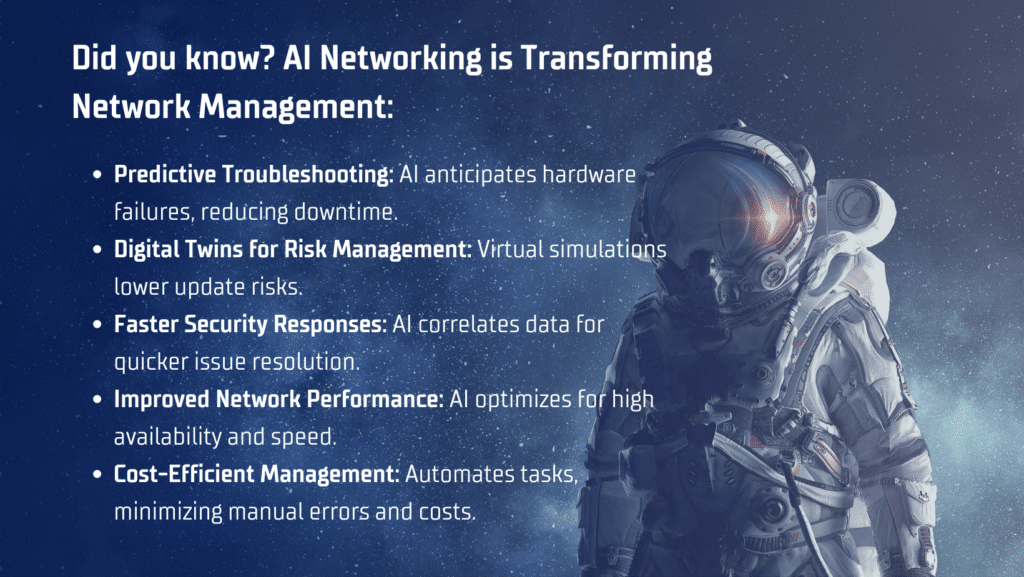7 Truths and a Lie: The Realities Behind the Surge in AI Networking Trends

Today’s enterprise networks are highly complicated, greatly extended, and hold numerous vulnerabilities. The chances of mistakes in configurations and updates have grown with network complexity and size and can be more consequential than ever before, but simply keeping such sprawling networks patched can be a nightmare.
While this alone is enough to significantly increase the risk landscape, network managers are also facing threats from multiple attack vectors, ranging from opportunistic hackers to state-sponsored cyber warfare. At the same time, they are under more pressure than ever to deliver constant uptime, top performance, and high speeds.
At this opportune moment, artificial intelligence (AI) and subsets like machine learning (ML) and natural language programming (NLP) arrived, promising to heal all problems and resolve every challenge in networking, just as in many other fields. AI networking does hold the capability to deliver improved network availability, performance and operational efficiency, so it’s not surprising to see the trend exploding, but many AI-powered promises are still mostly hype.
With every vendor offering some form of AI-driven solutions and tools, network operations teams are struggling to sort the wheat from the chaff. A recent report by Gartner reinforces the potential that AI networking holds, while also observing that the adoption rate is relatively low and slow for technology with so much promise.
In this article, we’ll discuss what AI networking is, plus the truths, and occasional lies, that abound regarding it. We’ll also review the barriers to adoption for netops teams, and share some points to consider when selecting a vendor for an AI networking solution.
What is AI Networking?
In brief, AI networking means using AI technologies for network management tasks. It’s seen as a subset of AIOps, and can also be referred to as intent-based networking, autonomous networking, self-driving networks, or self-healing networks.
With AI networking, you’ll apply AI and ML to generate and deliver granular, focused, and actionable insights into the network. Ultimately, the goal is to automate as many network management tasks as possible, including configuration, threat detection, problem resolution, and more. Here are the main capabilities included in AI networking:
Trend Analysis and Pattern Recognition
AI networking solutions analyze real-time and historical data to detect patterns and trends. This involves monitoring and observability, where the platform uses both historical data and real-time streaming data to establish baselines and refine individual patterns.
Anomaly Detection and Event Correlation
AI networking solutions automatically identify anomalies and correlate events across different data sources or domains. By leveraging baseline models, they can group related events based on time and network topology, reducing the need for human intervention and improving the accuracy of alerts and suggestions.
Closed-loop Problem Resolution and Automation
AI networking continuously learns and improves its response to important events by observing operator input and reinforcement mechanisms. It offers recommendations, automates responses, or triggers external automation systems to resolve issues more efficiently.
Generative AI
The arrival of generative AI made it possible to create detailed configurations and troubleshooting procedures based on human inputs. For instance, engineers can request the AI to design network architectures, or troubleshoot problems without explicit templates. This can streamline network management and reduce manual effort.
Digital Twins
AI networking increasingly integrates digital twins, which simulate non-production environments to validate network and security changes before deployment in production environments. Digital twins can be part of continuous integration/continuous delivery pipelines, ensuring that networks function as expected and allowing for “what-if” analysis on modeling scenarios.
7 Truths and a Lie About AI Networking
As mentioned above, AI networking promises a great deal of benefits for network operations teams. Some of these are already manifest and leading enterprises are already enjoying the competitive advantage it gives them, while others remain in potential and have yet to be fully actualized. Some of these benefits of AI networking include:
1. Minimized Downtime Through Proactive Fault Detection
AI networking harnesses predictive analytics to foresee potential hardware failures. By analyzing historical data patterns and real-time telemetry, AI algorithms can anticipate malfunctions in components such as ASICs, CPUs, or flash drives. This proactive approach allows for the scheduling of replacements during non-peak hours, minimizing disruptions to operations and reducing downtime.
2. Risk Reduction with Change Management
Digital twins, which are virtual representations of network environments, help lower the risks of change by enabling network administrators to simulate proposed changes and conduct “what if” scenarios to evaluate potential impacts before implementation. By identifying and mitigating the risks associated with network modifications and updates, AI-driven change management enhances decision-making, increases change efficacy, and fosters a culture of proactive risk management within organizations.
3. Enhanced Security Thanks to Faster Issue Resolution
AI can correlate multiple datasets and uncover root causes, empowering network operators to delve deep into network performance issues. Through sophisticated data analytics, AI algorithms can detect relationships between network events to pinpoint underlying issues. This helps expedite issue resolution, reduce service disruptions, and enhance overall network reliability. Moreover, AI-powered chatbots provide real-time recommendations for troubleshooting, facilitating rapid response to security incidents.
4. Improved Network Availability and Performance
Through advanced algorithms, continual monitoring, and predictive analytics, AI systems identify potential bottlenecks in real-time, optimizing network resources to ensure consistent service availability and high application performance. AI-driven dynamic network adaptation enables swift adjustments to changing environmental conditions and user demands, minimizing latency and ensuring seamless connectivity for end-users.
5. Lower Costs Through Simplified Network Management
AI networking streamlines network management processes and reduces operational costs by automating routine tasks and minimizing the need for extensive manual intervention. Eliminating manual configuration errors and streamlining troubleshooting workflows helps accelerate problem resolution, reduce downtime, and enhance overall productivity. It also helps lower the need for deep networking skills, at a time when experts are hard to find, and empowers teams to reallocate resources strategically, drive innovation, and achieve sustainable cost savings.
6. Optimized Resource Allocation with AI network Monitoring
By reducing false alerts and generating actionable insights, AI-driven network monitoring enables organizations to prioritize critical issues, allocate resources more efficiently, and enhance operational effectiveness. Using AI for anomaly detection facilitates early intervention, preventing minor issues from escalating into major incidents and minimizing the impact on business operations. Through continuous refinement, AI networking enhances network resilience, improves resource utilization, and fosters a culture of proactive problem-solving.
7. Widespread Automation and Reduced Manual Effort
The final goal for AI networking is to automate repetitive tasks, accelerate workflows, and reduce human error, in tasks that range from network provisioning and configuration management to troubleshooting and remediation. This not only enhances operational agility and scalability, but also liberates IT teams to focus on strategic initiatives and innovation, achieve operational excellence, and deliver superior business outcomes.
8. The Lie: Automated AI Networking is Immediately Accessible
Through all these advantages, AI networking has the potential to drive significant improvements in operational efficiency, raise security levels, lower costs, and noticeably increase network performance and end user satisfaction. However, few vendors offer solutions that can truly automate network management in ways that minimize manual input and deep technical expertise. There also aren’t many organizations that are in a position to implement them to their fullest extent. AI networking in its full capacity can be said to be on the way, but it hasn’t yet truly arrived.
The State of AI Networking
Despite operating on the cutting edge of technology, netops personnel tend to be risk-averse and nervous about adopting new working practices. Many network management teams don’t trust AI-powered recommendations for remediation or problem resolution, even if they accept the value of AI’s early alerts. Those who do adopt AI suggestions often feel the need to validate the outcomes before implementing them, which can remove some of the value in terms of time saved.
As a result, adoption rates and the value that AI networking is realizing within enterprises is still nascent, according to Gartner. Yet the hopes and expectations for AI networking are high. To avoid disappointment and ensure the eventual realization of these hopes, network operations teams need to take a smart approach to implementation.
It’s important to start on a small scale and prove functionality. Testing in a POC environment before moving to production, and beginning with human-in-the-loop solutions, allows you to grow trust within the workforce, before graduating to fully autonomous systems.
Choosing the Right AI Networking Vendor Can Be Crucial
Another important element is choosing the right vendor. There are currently a number of ways to deliver AI networking, including:
- Offering it as a feature within a network vendor’s management platform
- Serving a standalone multi-vendor platform
- Building it into an AIOps platform
- Delivering it as a service as part of a managed network service
Since AI networking is still evolving, pay attention to the vendor’s promises for the future. Some might make exaggerated claims about future capabilities. Look for vendors that can give detailed descriptions about current features and those yet to come, as well as timelines and a concrete roadmap for at least the next 1-2 years.
Recommended reading: What Is Network Automation & Why Your Business Needs It?
Many network equipment vendors and legacy solutions claim to add AI capabilities to their offering, but serve up only point solutions. While the AI components may make their solution faster or stronger, it’s not able to take full advantage of the potential. Instead, look for end-to-end, multi-vendor coverage that will be able to truly support autonomous and self-healing networks.
Another crucial issue to look for is vendor agnostic or multi-vendor capabilities. Enterprise networks are becoming more heterogeneous, increasingly including hybrid environments, multi-cloud environments, and legacy servers. Adopting single vendor solutions only risks adding to your siloed tools and growing your tech stack out of all proportion.
The True Gift of AI Networking is Rapidly Becoming a Reality
While AI networking is still young and not yet able to deliver on all of its promises, its time is coming up quickly. AI networking still has a way to go to deliver all these benefits, but leading adopters can expect to enjoy a measurable competitive edge. Forward-thinking organizations that implement existing capabilities of AI network management and work with the right vendors from an early stage will be better placed to maximize the benefits that AI networking can bring.


